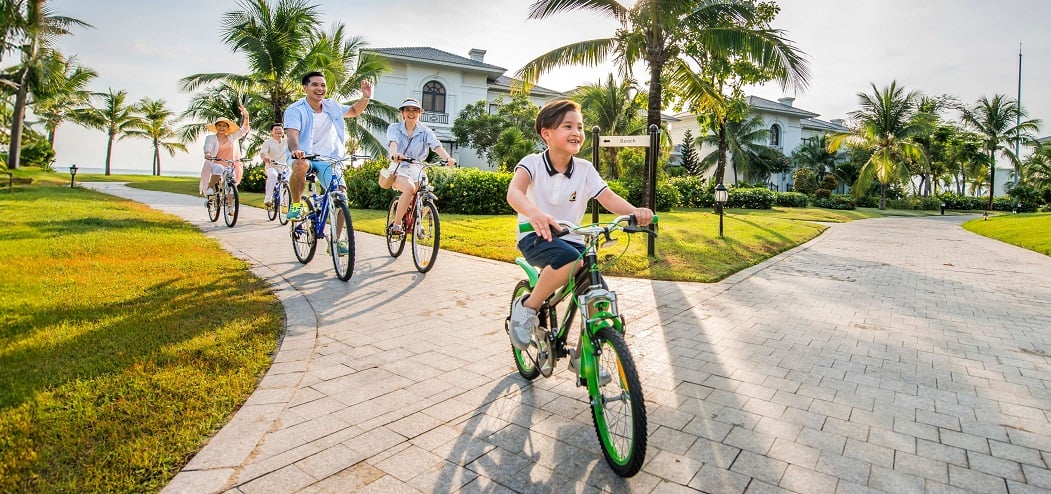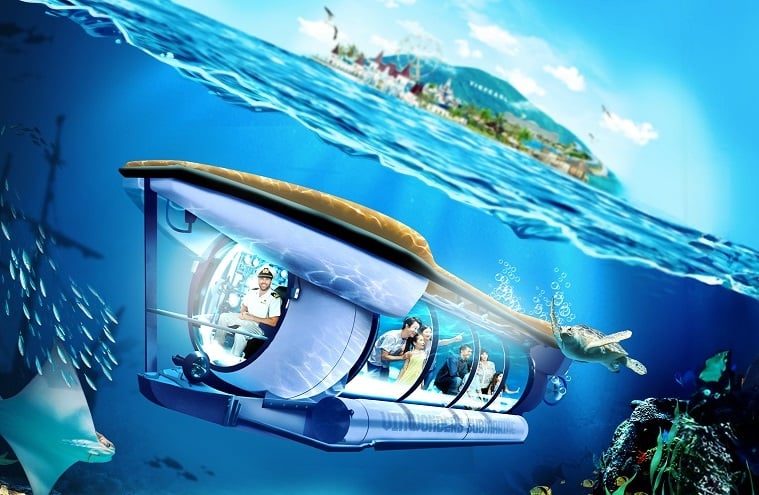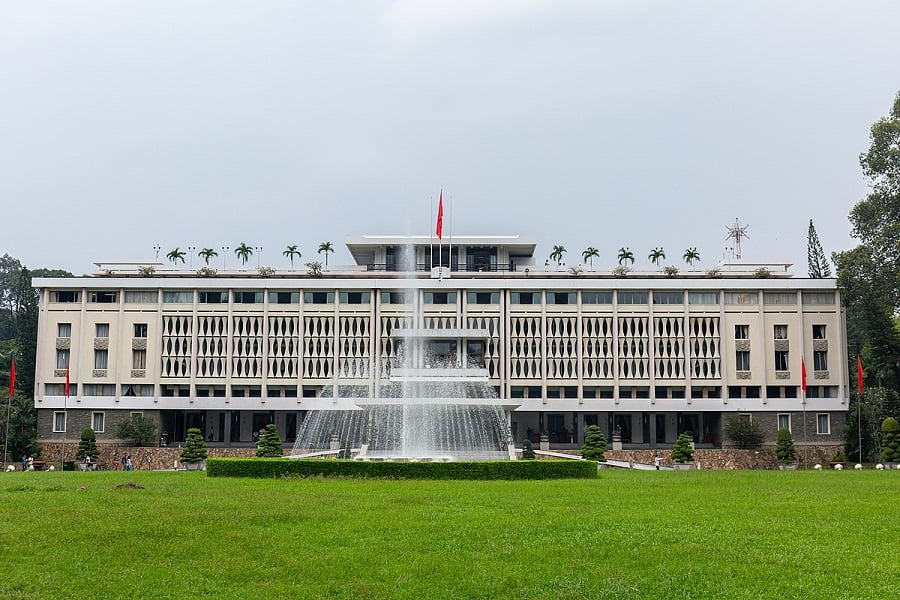
The Independence Palace symbolizes Vietnam's victory, peace, and territorial integrity. This place has a glamorous design, hundreds of rooms equipped with luxurious furnishings and decorations, and an enormous and gorgeous exterior space. It is the perfect place for visitors to get away from the heat in Southern Vietnam, enjoy the fresh cool air, and explore one of the most remarkable structures in Ho Chi Minh City.
1. Where is Independence Palace Saigon?
The Independence Palace, also known as the Reunification Palace, was built on the site of the former Norodom Palace. It represents the traditional philosophy, the oriental rituals, and the characteristics of the Vietnamese people in a harmonious combination with modern structures.

The Palace, a landmark in Ho Chi Minh City, covers 120,000 square meters (300 meters x 400 meters). It is adjacent to four major streets: Nam Ky Khoi Nghia Street to the northeast, Huyen Tran Cong Chua Street to the southwest, Nguyen Thi Minh Khai Street to the northwest, Nguyen Du Street to the southeast.
It is also adjacent to 30-4 Park at the front and to Tao Dan Cultural Park at the rear. The Palace campus has many ancient trees, many of which date back to the French period. For those who appreciate art and architecture, this palace is one of the most appealing attractions in Ho Chi Minh City.
- Location: 135 Nam Ky Khoi Nghia Street, Ben Nghe Ward, District 1, Ho Chi Minh City
2. History of Independence Palace Vietnam
After the French conquered six provinces in South Vietnam (Cochinchine), they built Norodom Palace in 1868 as a residence for the Governor-General, which took three years to complete. The French Governor of Cochinchine used the palace from 1871 to 1887 and called it the Governor's Palace. During the Indochina invasion, all Governors-General of French Indochina used the palace as their residence and working place from 1887 to 1945.
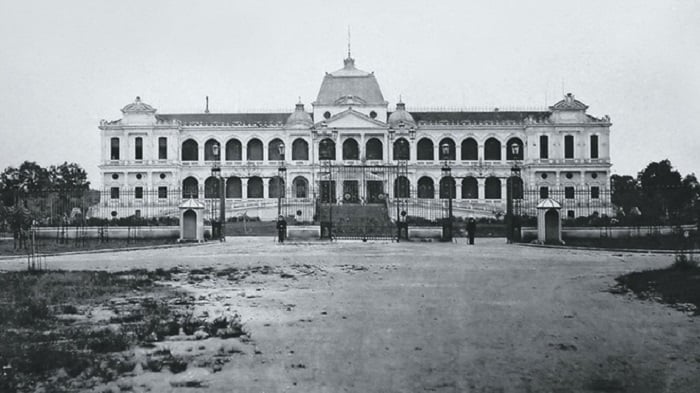
On March 9, 1945, Japanese forces overthrew the French and seized complete control of Indochina. Norodom Palace was designated as the Japanese headquarters in Vietnam. With the defeat of the Japanese in World War II, the French returned to occupy Southern Vietnam in September 1945. Norodom Palace was again designated as the French regime's headquarters in Vietnam.
The French were defeated at Dien Bien Phu in May 1954, forcing them to sign the Geneva Agreements and withdraw their troops from Vietnam. The United States entered the fray to occupy the South. As a result, Vietnam was temporarily divided into two regions: the North, led by the Democratic Republic of Vietnam, and the South, led by the newly proclaimed Republic of Vietnam, led by Ngo Dinh Diem and funded by America. The Norodom Palace was also renamed Independence Palace and became Ngo Dinh Diem's office and residence.

A rebellious bombing in February 1962 irreparably damaged the palace, and as a result, Ngo Dinh Diem ordered that a new one be built. Construction began in 1962 according to the design of the Vietnamese architect Ngo Viet Thu. But Ngo Dinh Diem did not have a chance to see it because he and his brother were assassinated in 1963 before the palace was completed in 1966. The new Independence Palace then served as Nguyen Van Thieu's home and workplace from 1967 to 1975.
On 30 April 1975, two North Vietnamese Army tanks crashed down the walls of the Independence Palace, resulting in the Republic's fall in Vietnam, the end of the Vietnam War, and the reunification of the entire country. Nowadays, this destination is still known by two names in Vietnam: the Independence Palace and the Reunification Palace.
You may also like:
- Vietnamese Reunification Day: Date, History & Celebration Activities
- Best places to visit in Vietnam: TOP 15+ exotic spots not to be skipped
- Airlines in Vietnam: TOP 5 best domestic brands for passengers
3. Independence Palace's architecture
The palace was built on a 12-hectare plot of land and includes a large mansion of 80-meter width. The palace is well-known not only for its historical significance but also for its unique architecture. It is a harmonious blend of modern Western and classical Eastern styles.
3.1. Exterior
In the front yard is an oval lawn with a diameter of 102 meters. As soon as visitors pass through the gate, they will see the green grass which creates a calming and refreshing feel. A semicircular lake runs the length of the yard. There are lotus and water lilies in the lake, making it resemble the peaceful lakes in Vietnam's ancient temples and pagodas.

There are two green parks in front of and behind the palace. The main building has three floors, two mezzanines, one terrace, one ground floor, and a basement. The total usable space is 20,000 square meters, which is divided into 100 rooms. Each room has its own function with the corresponding architecture and decoration. After 1975, some of the main buildings' spaces have remained in use, while the rest are used to serve visitors.

On the left side of this palace, facing Nguyen Thi Minh Khai Street, an octagonal house built on a high mound with an antique curved tile roof creates a relaxing place. There are lush lawns, old gardens, precious potted plants around the palace and four tennis courts behind the main building.
3.2. Interior
The hall is surrounded on both sides by the walls of the dining room and the cabinet meeting room with a prominent large wooden staircase in front. This hall has a lot of space. It's airy and decorated simply.

After passing through the main gate, visitors must follow an arched trail around the oval lawn to reach the palace. Aside from the stunning staircase and hall, each room of the Independence Palace has its unique and magnificent beauty.
- The Chamber: The room, which can accommodate over 800 people, has been used for meetings, receptions, and cabinet launch ceremonies.
- The credentials room: the painting "Binh Ngo Dai Cao" – meaning "the Proclamation Of Victory" – is the most notable object in the room. It includes 40 pieces depicting the peaceful Vietnamese life in the 15th century.
- Library: This room contains the books and research papers of many former presidents.
- Strategic Operations Department room: This is the room where the military data from four tactical regions were collected. The soldiers would update, monitor, and deploy military operations using the combat map system here.
- Residence of the Presidential Family: Nguyen Van Thieu, the former President of Vietnam, has the longest staying time here (from October 1967 to April 21, 1975).
- Basement: The basement was designed by Lieutenant Colonel, Engineer Phan Van Dien, the Chief of the Independence Palace, and is beneath the palace. The tunnel measures 72.5 meters in length, 0.8 to 22.5 meters in width, and 0.6 to 2.5 meters in depth. The basement rooms are linked by small entrances, armored walls, and ventilation systems.
Other rooms that will attract visitors' interest include the ballroom, the cinema room, the reading room, and many more.

Besides, other sections are now open to visitors, such as the Thematic area. It is a display area for old articles and photographs. Visitors can not only look at the vivid photos from the past, but they can also learn more about the historical details hidden in them.
Notably, there is a particular exhibition area in the Independence Palace titled "from Norodom Palace to Independence Palace, 1868 to 1966." This is a fascinating attraction for history buffs because it shows the formation, construction, historical milestones, and important events at the Independence Palace in Ho Chi Minh City, Vietnam.

4. What to do at Independence Palace Saigon
When you first enter the Independence Palace, you will feel utterly peaceful because the primary color covering the entire site is green. It is a five-story building with a system of tunnels, a war room, and a telecommunications center in the basement.
4.1. Historical artifacts
The historical artifacts in the Independence Palace represent Vietnam's heroic history. The objects have been well-preserved and kept in perfect condition so that visitors can observe and admire them.

- The historic helicopter: On the roof of the Independence Palace, there is a display of President Nguyen Van Thieu's UH-1 helicopter, next to where the two bombs that pilot Nguyen Thanh Trung dropped.
- The German Mercedes: The German car Mercedes Benz 200 W110 with the plate number VN-13-78 was a car that President Nguyen Van Thieu used.
- The Jeep: The Revolutionary Forces used the Jeep M152A2. It is unique because it was used to transport Mr. Duong Van Minh, the last President of the Republic of Vietnam, to the Saigon radio station, where he read the declaration of surrender at noon on April 30th, 1975.
4.2. Artworks
The Independence Palace not only exhibits historical artifacts but also displays several valuable works of art.

- Oil paintings: There is an oil painting of the Vietnamese countryside drawn by architect Ngo Viet Thu. Another oil painting depicts the sisters Thuy Kieu and Thuy Van meeting Kim Trong for the first time on the Ancestral Anniversary (also known as the Day of Tending Graves).
- Pottery: There are dozens of ancient Chinese pots of the Ming and Qing dynasties in the Independence Palace.
4.3. Independence Palace Tanks
The model-843 tank was manufactured in Russia, and it was the first tank to try to ramp down the gates of the Independence Palace in April 1975. It failed to bring down the gate, and it was the model-390 tank which crushed the gate and moved further into the palace's main yard.

This historical moment marked the success of the long Ho Chi Minh revolutionary campaign and Vietnam's official reunification and independence. Both of the tanks in the palace’s yard are replicas of the real ones currently on display in Hanoi.
Articles for you:
- Pho Saigon: 12 places to find top-notch pho around Ho Chi Minh City
- Ben Thanh Market: Explore the long-standing symbol of Ho Chi Minh City
- Nightlife in Ho Chi Minh City: TOP 12+ ideal places to spend your evening
5. Detailed travel guide for visiting the Independence Palace in Vietnam
5.1. How to get to the Independence Palace
The Independence Palace is in District 1, so you can easily get there by bus, taxi, car, or motorbike. Tourists should keep in mind that the building's front gate faces the intersection of Le Duan Street and Nam Ky Khoi Nghia Street. Look for this intersection if you can't find the correct address.

- On foot/ by motorcycle/ private car: If you are traveling on your own by motorcycle or on foot, ask for directions from any local. If you stay in a hotel in District 1, you can walk to the Independence Palace in 15 to 20 minutes. Note: you can park at Tao Dan Park or on the side of the palace (on Huyen Tran Cong Princess Street).
- By taxi: You can take a cab and tell the driver to take you to the Independence Palace if you don't want to waste time looking for directions. The building stands out on the streets of Saigon, making it easy to be recognized.

For an environmentally conscious choice, consider opting for XANH SM Taxi. XANH SM Taxi - the first electric taxi company in Vietnam, operated entirely with VinFast electric cars. Customers who travel by XANH SM taxi not only receive an excellent standard of service, but they also join XANH SM in its efforts to reduce vehicle emissions and safeguard the environment. XANH SM provides standard and luxury taxi service, airport taxi, with attractive promotions. Customers can easily book a taxi in 04 ways:
(1) Call the national hotline 1900 2088
(2) Wave on the street like a traditional taxi
(3) Book on the Taxi Xanh SM app. Click HERE to download the app
(4) Use the beVinFast service on the multi-service customer platform BE to book Xanh SM taxi
- By bus: There are some specific bus routes for those who want to save money, such as:
- 001: Ben Thanh – Cho Lon
- 002: Ben Thanh – Mien Tay
- 03: Ben Thanh – Thanh Loc
- 04: Ben Thanh – Cong Hoa – An Suong
- 05: Cho Lon – Bien Hoa
5.2. Opening hours
The Independence Palace is open from Monday to Sunday, including holidays and Tet, from 8 a.m. to 4:30 p.m. The ticker office is opened from 8 a.m. to 3:30 p.m.
5.3. Entrance fee
The entrance fee is 40.000 VND/adult, 20.000 VND/student, and 10.000 VND/child.
Note: Depending on the section/exhibition you wish to visit, there may be other types of entrance fee.

6. Things to note before visiting the Independence Palace in Ho Chi Minh City
Because the Independence Palace is a significant historical site, you must strictly adhere to the monument's rules. Visitors will be held accountable if they cause any damage to the palace.
- Dress formally and avoid wearing skirts or shorts.
- During the visit, follow the guard's instructions and the signs.
- Do not bring luggage/ food or drinks/ animals/ weapons, explosives, or toxic chemicals into the monument.
- Be responsible if you cause any damage to the monument.
Vietnam is blessed with a diverse range of captivating destinations, each offering its own unique charm and allure. In addition to the unique and alluring beauty of Ho Chi Minh City, there are other appealing places worth visiting in Vietnam, such as Hanoi, Ho Chi Minh City, Nha Trang, Phu Quoc, Hoi An, and Ha Long.
After exploring these renowned attractions, you can unwind and relax at the exceptional hotels and resorts offered by Vinpearl. With its luxurious rooms, breathtaking views, and all-inclusive amenities, Vinpearl provides an exceptional stay for those seeking a rejuvenating retreat. Besides, you should not miss visiting VinWonders - an enchanting entertainment paradise that promises immersive experiences, exhilarating rides, and exciting adventures.

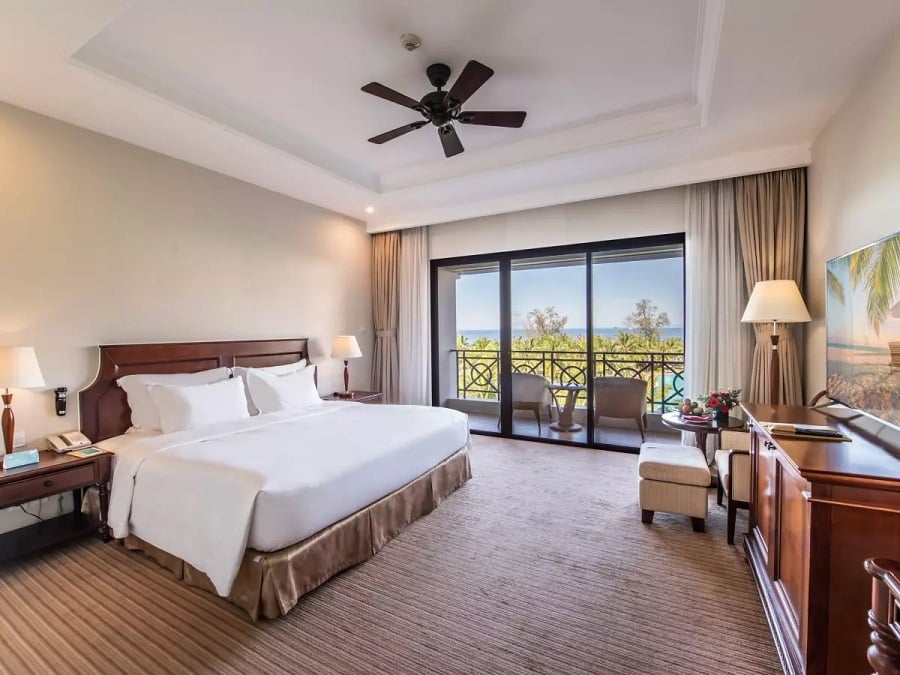
>>> Book rooms in Vinpearl Phu Quoc, Vinpearl Nha Trang, Vinpearl Resort & Golf Nam Hoi An, Vinpearl Resort & Spa Ha Long for an impeccable experience!
The Independence Palace is not only a heroic symbol of Ho Chi Minh City, but also the pride of the Vietnamese people. Exploring this historic site will be a memorable experience, especially for foreign visitors interested in Vietnam's heroic past. If you are interested in history, this is a must-see destination.






